If you’re struggling to find the perfect greenery for your dimly-lit apartment or home, look no further. Hanging plants that thrive in low-light environments bring life and beauty to even the shadiest corners of your indoor space. Plus, they’re great for purifying the air and adding a natural, calming vibe to your decor.
Whether you’re a beginner gardener or an experienced plant enthusiast, this list of 14 low-light hanging plants will help you refresh your space with minimal effort. We’ll explore what makes each plant unique and give you tips to keep them thriving.
1. Golden Pothos (Epipremnum aureum)
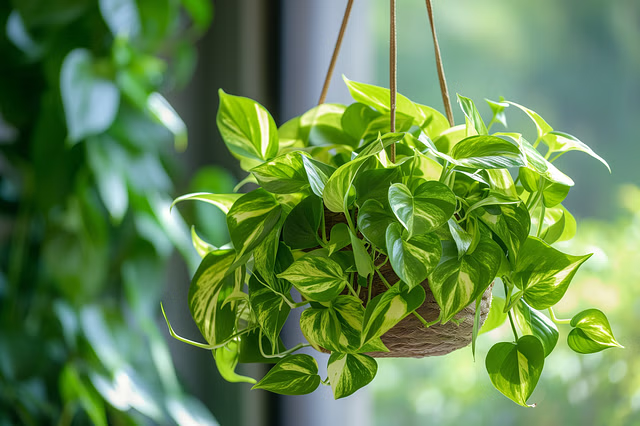
Also known as Devil’s Ivy, Golden Pothos is one of the best Low Light Hanging Plants, perfect for brightening up dim corners of your home. This hardy plant features trailing vines with green, heart-shaped leaves accented by stunning yellow variegation, making it a beautiful yet low-maintenance choice.
Tips for Care:
- Thrives in Low Light: Unlike many plants, Golden Pothos adapts well to low-light conditions, making it ideal for indoor spaces with minimal sunlight.
- Watering Needs: Allow the top inch of soil to dry out before watering. Overwatering can lead to root rot.
- Air-Purifying Benefits: This plant not only enhances indoor decor but also helps purify the air by removing toxins.
- Versatile Growth: Perfect for hanging baskets, wall-mounted planters, or even training along shelves and trellises.
With its cascading vines and easy-care nature, Golden Pothos is a must-have for anyone looking to add lush greenery to their collection of Low Light Hanging Plants.
2. Spider Plant (Chlorophytum comosum)
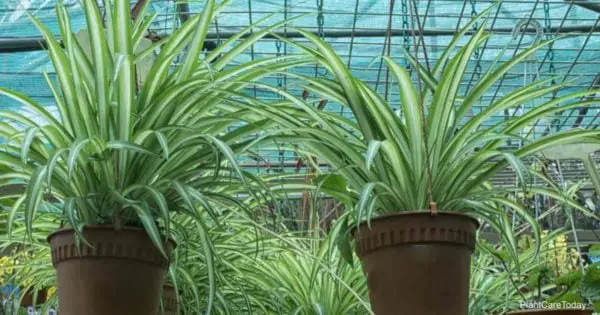
The Spider Plant is one of the easiest and most resilient Low Light Hanging Plants, making it an excellent choice for beginners. Its arching green leaves with elegant white stripes create a striking display, especially in hanging baskets.
As it matures, this plant produces baby offshoots, known as “spiderettes,” that dangle gracefully from the mother plant, adding to its charm.
Tips for Care:
- Low-Light Adaptability: While it prefers indirect sunlight, the Spider Plant can tolerate lower light conditions, making it ideal for offices and dim corners.
- Watering Needs: Allow the topsoil to dry out before watering. Avoid overwatering, as soggy soil can lead to root rot.
- Easy Propagation: Simply snip and replant the baby spiderettes to grow new plants.
- Air-Purifying Qualities: Known for removing indoor toxins, this plant improves air quality while enhancing your home’s aesthetic.
With its cascading growth and minimal care requirements, the Spider Plant is a standout addition to any collection of Low Light Hanging Plants.
3. Heartleaf Philodendron (Philodendron hederaceum)
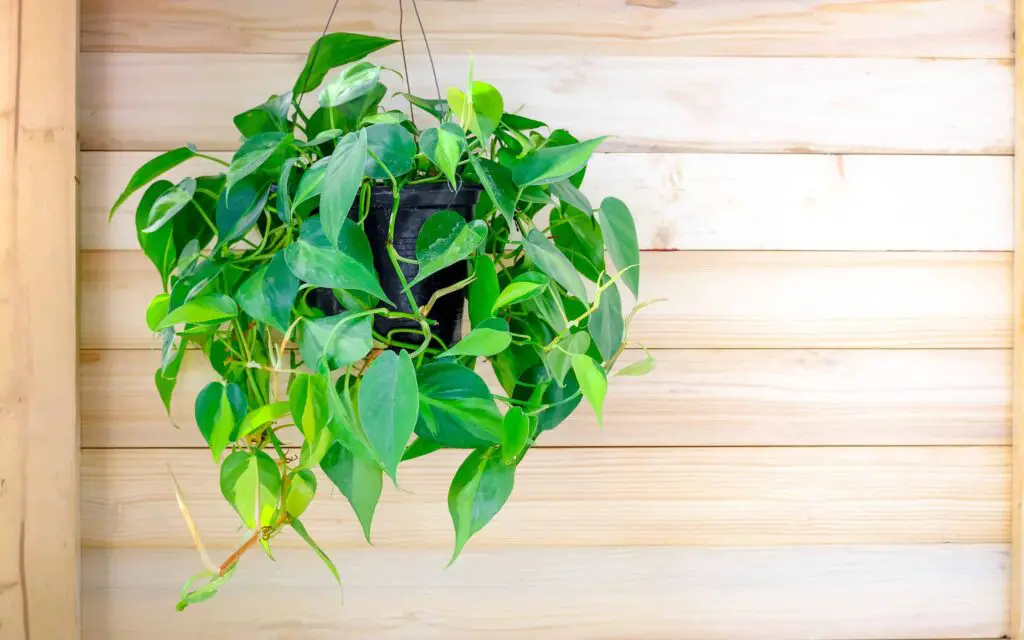
A classic choice for Low Light Hanging Plants, the Heartleaf Philodendron is beloved for its lush, trailing vines and glossy, heart-shaped leaves. This fast-growing plant thrives in dimly lit spaces, adding a tropical touch to any indoor setting. Its cascading foliage makes it perfect for hanging baskets, wall-mounted planters, or high shelves.
Tips for Care:
- Thrives in Low Light: Adaptable to various lighting conditions, though it grows best in indirect light.
- Watering Needs: Water only when the soil begins to dry out. Overwatering can cause root rot.
- Encourage Bushy Growth: Prune long vines occasionally to keep the plant full and prevent tangling.
- Pet Safety: This plant is toxic if ingested, so keep it out of reach of pets and children.
With its effortless beauty and minimal care requirements, the Heartleaf Philodendron is a must-have for any indoor garden featuring Low Light Hanging Plants.
4. Boston Fern (Nephrolepis exaltata)

The Boston Fern is a stunning choice for those looking to add texture and vibrancy to their collection of Low Light Hanging Plants. Its arching, feathery fronds create a lush, cascading effect, making it a perfect addition to hanging baskets. While Boston Ferns thrive in humid environments, they can adapt to low light conditions with the right care.
Tips for Care:
- Moisture is Key: Keep the soil consistently moist but well-drained to prevent root rot.
- Increase Humidity: Mist the plant regularly or place a humidifier nearby to replicate its natural rainforest habitat.
- Avoid Drafts: Keep the fern away from cold air vents and drafts, as sudden temperature changes can cause leaf drop.
- Low-Light Tolerance: While it flourishes in indirect light, it can adapt to lower light levels with proper humidity.
With its graceful, flowing fronds and air-purifying benefits, the Boston Fern is an excellent addition to any space featuring Low Light Hanging Plants.
5. English Ivy (Hedera helix)
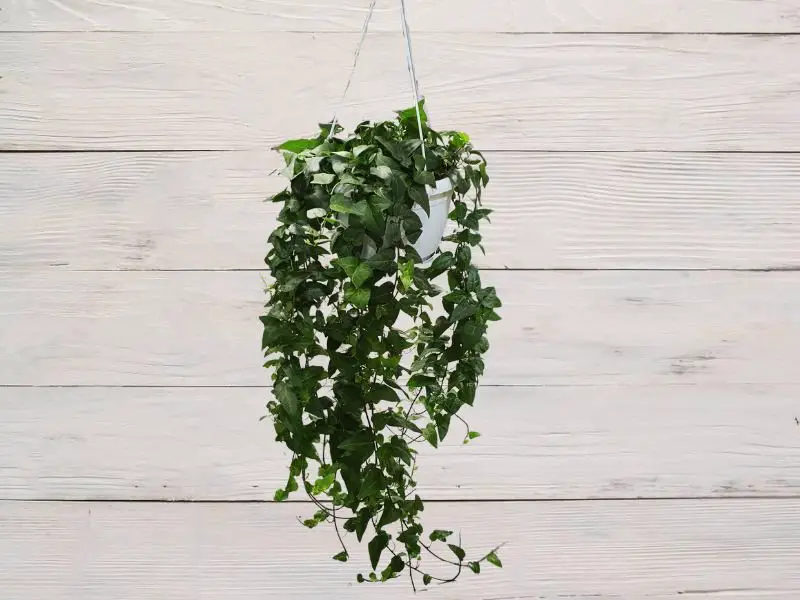
A timeless favorite among Low Light Hanging Plants, English Ivy is a versatile climber that looks stunning when allowed to trail elegantly from a hanging basket. With its delicate, cascading vines and classic lobed leaves, this plant adds an effortless touch of greenery to any indoor space.
It thrives in low-light conditions, making it an excellent choice for rooms with minimal sunlight.
Tips for Care:
- Watering Needs: Allow the soil to dry slightly between waterings to prevent overwatering and root rot.
- Good Air Circulation: Ensure proper airflow around the plant to reduce the risk of fungal issues.
- Regular Pruning: Trim vines frequently to maintain a compact, healthy shape and encourage new growth.
- Adaptability: English Ivy adjusts well to different indoor conditions and can even be trained along walls or trellises.
With its classic beauty and ability to thrive in low-light environments, English Ivy is a must-have for any collection of Low Light Hanging Plants.
Related Topics:
6. String of Hearts (Ceropegia woodii)

A standout among Low Light Hanging Plants, the String of Hearts is a stunning trailing plant with delicate, heart-shaped leaves on long, cascading stems. Its unique appearance and easy-care nature make it a favorite for plant lovers seeking something both elegant and low-maintenance.
While it prefers bright, indirect light, it can adapt to low-light spaces, making it perfect for cozy indoor settings.
Tips for Care:
- Water Sparingly: Allow the soil to dry out completely between waterings, as this plant is sensitive to overwatering.
- Use Well-Draining Soil: A light, airy potting mix (such as a cactus or succulent blend) helps prevent root rot.
- Ideal Placement: Perfect for hanging near small windows or in dim corners where its trailing vines can create a beautiful cascading effect.
- Encourage Growth: If stems become leggy, trim them back slightly to promote fuller growth.
With its graceful vines and charming foliage, the String of Hearts is an excellent choice for anyone looking to add unique beauty to their collection of Low Light Hanging Plants.
7. Maidenhair Fern (Adiantum)
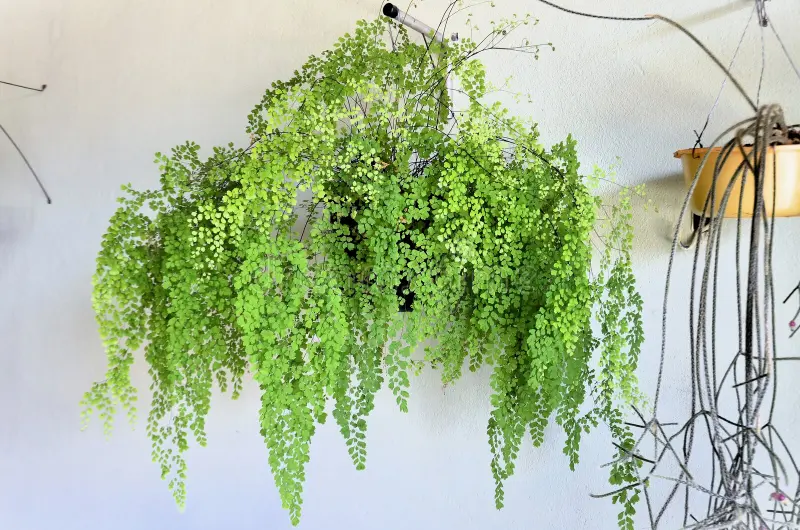
The Maidenhair Fern is one of the most graceful Low Light Hanging Plants, known for its delicate, lacy foliage that adds a soft, elegant touch to any indoor space. Its feathery fronds create a beautiful cascading effect, making it a perfect choice for hanging baskets.
Though it requires a bit more attention than other ferns, its beauty is well worth the effort.
Tips for Care:
- Keep Soil Moist: This plant requires consistently moist soil—never let it dry out completely.
- Increase Humidity: Prefers a humid environment, so mist the leaves regularly or place a small tray of water nearby.
- Avoid Drafts: Keep away from drafty windows, air conditioners, or direct heat sources to prevent stress.
- Low-Light Adaptability: Thrives in indirect light and shaded spots but should be kept away from direct sunlight, which can scorch its delicate leaves.
With its soft, feathery foliage and love for humidity, the Maidenhair Fern is an excellent addition to any collection of Low Light Hanging Plants.
8. String of Pearls (Senecio rowleyanus)
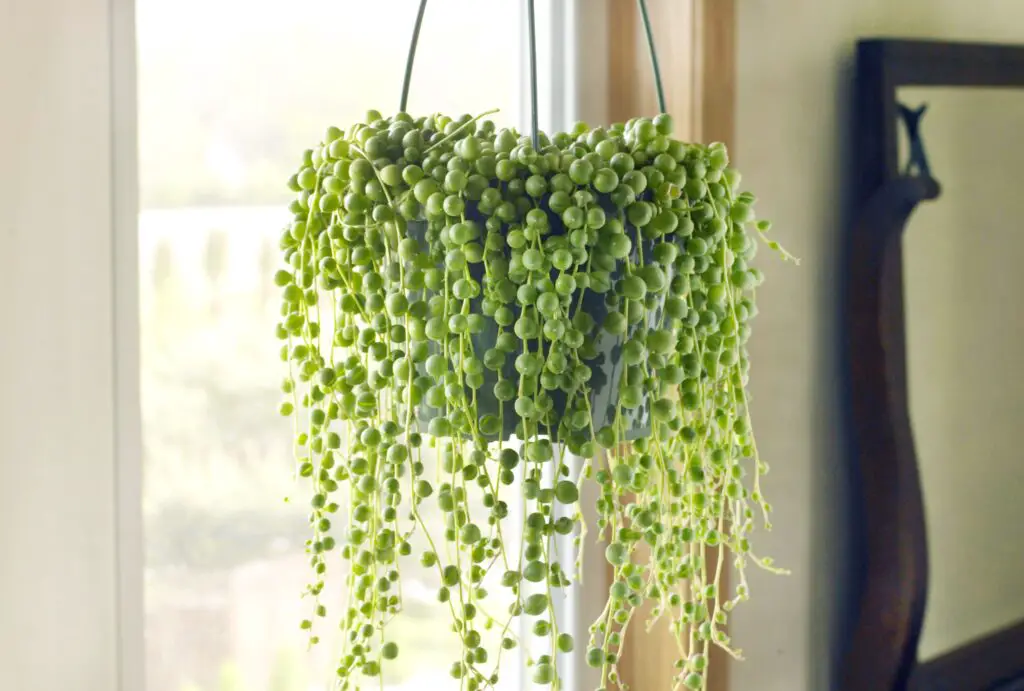
A truly unique addition to Low Light Hanging Plants, the String of Pearls is known for its trailing vines adorned with small, bead-like leaves. This eye-catching succulent creates a stunning waterfall effect in hanging baskets, making it a perfect statement piece for shelves, corners, or window sills.
While it thrives in bright, indirect light, it can adapt to lower light conditions with proper care.
Tips for Care:
- Water Sparingly: Allow the soil to dry out completely between waterings to prevent root rot.
- Use Well-Draining Soil: A cactus or succulent potting mix helps maintain proper moisture balance.
- Encourage Even Growth: Rotate the pot occasionally to ensure all sides receive equal light exposure.
- Low-Maintenance Beauty: This plant requires minimal care and is perfect for those looking for an elegant yet easy-to-grow hanging plant.
With its distinctive trailing pearls and easy-care nature, the String of Pearls is a must-have for any collection of Low Light Hanging Plants.
9. Bird’s Nest Fern (Asplenium nidus)
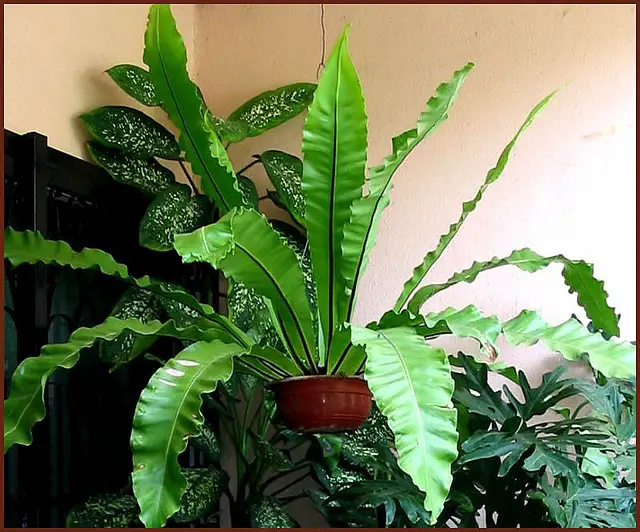
A striking choice among Low Light Hanging Plants, the Bird’s Nest Fern features glossy, wavy-edged fronds that bring a lush, tropical vibe to any indoor space. Unlike other ferns with delicate, feathery foliage, this plant has broad, sturdy leaves that add texture and greenery to low-light areas.
Tips for Care:
- Water Correctly: Always water directly into the soil, avoiding the center “nest” to prevent rot.
- Maintain Moisture: Keep the soil consistently moist but never soggy to avoid root issues.
- Loves Humidity: Thrives in humid environments, making it a great choice for bathrooms or kitchens.
- Low-Light Tolerant: While it prefers indirect light, it adapts well to lower light conditions, making it perfect for shaded corners.
With its bold foliage and easy-going nature, the Bird’s Nest Fern is a beautiful and low-maintenance addition to any collection of Low Light Hanging Plants.
10. Hoya Linearis
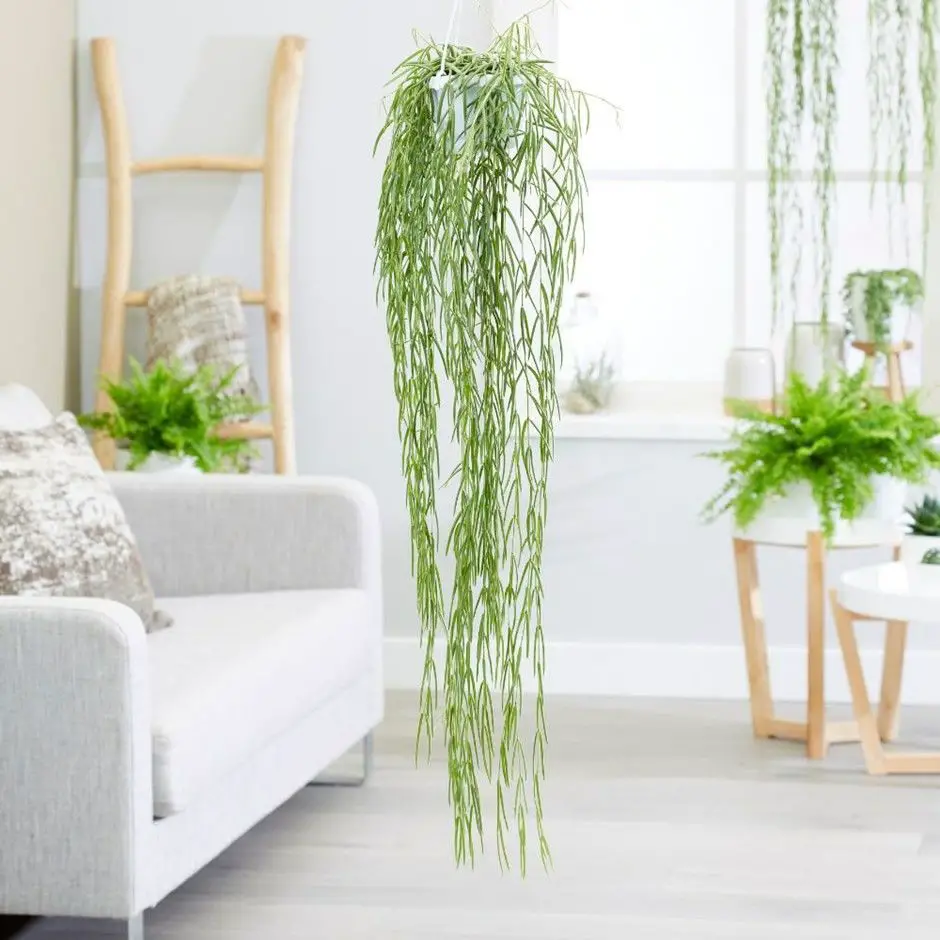
A favorite among plant lovers, Hoya Linearis is a unique addition to Low Light Hanging Plants, featuring long, cascading stems covered in soft, needle-like leaves.
Unlike other Hoya varieties with waxy foliage, this species has a delicate, trailing appearance that adds a beautiful, flowing texture to any indoor space. Its low-maintenance nature makes it perfect for dimly lit apartments or offices.
Tips for Care:
- Watering Needs: Allow the soil to dry out completely between waterings, as Hoyas are drought-tolerant.
- Light Preferences: Grows best in moderate to low indirect light but can adapt to lower light conditions.
- Boost Humidity: Occasional misting helps maintain humidity, especially in drier environments.
- Minimal Maintenance: This slow-growing plant requires little pruning and thrives with minimal care.
With its elegant trailing vines and easy-care nature, Hoya Linearis is a must-have for any collection of Low Light Hanging Plants.
11. Dischidia Ruscifolia (Million Hearts Plant)
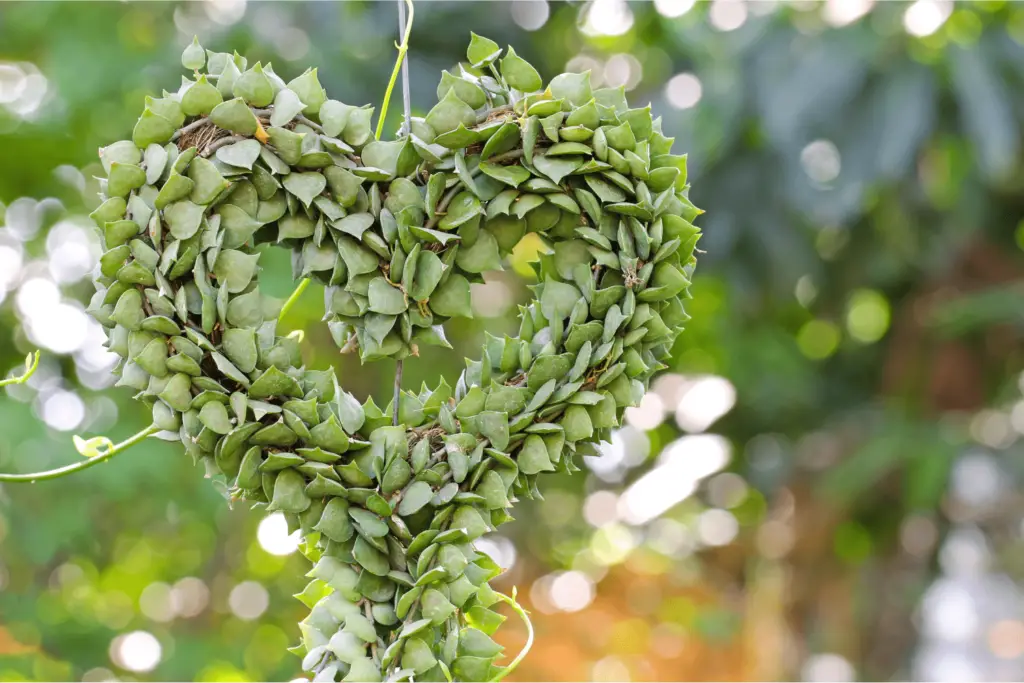
A delightful addition to Low Light Hanging Plants, the Million Hearts Plant is named for its tiny, firm, heart-shaped leaves that grow densely along its cascading vines. This charming plant creates a lush, trailing effect, making it perfect for hanging baskets or wall-mounted planters.
It thrives in indoor spaces with minimal light and requires little upkeep.
Tips for Care:
- Low to Medium Light: Prefers indirect light but can adapt to lower light conditions.
- Watering Needs: Allow the top 2 inches of soil to dry before watering—overwatering can lead to root rot.
- Well-Draining Soil: Use a light, airy potting mix to accommodate its thin roots and prevent water retention.
- Compact & Versatile: Its dense foliage makes it ideal for creating a vibrant, cascading display in any indoor space.
With its delicate heart-shaped leaves and minimal care requirements, the Million Hearts Plant is a must-have for any collection of Low Light Hanging Plants.
12. Peperomia Hope
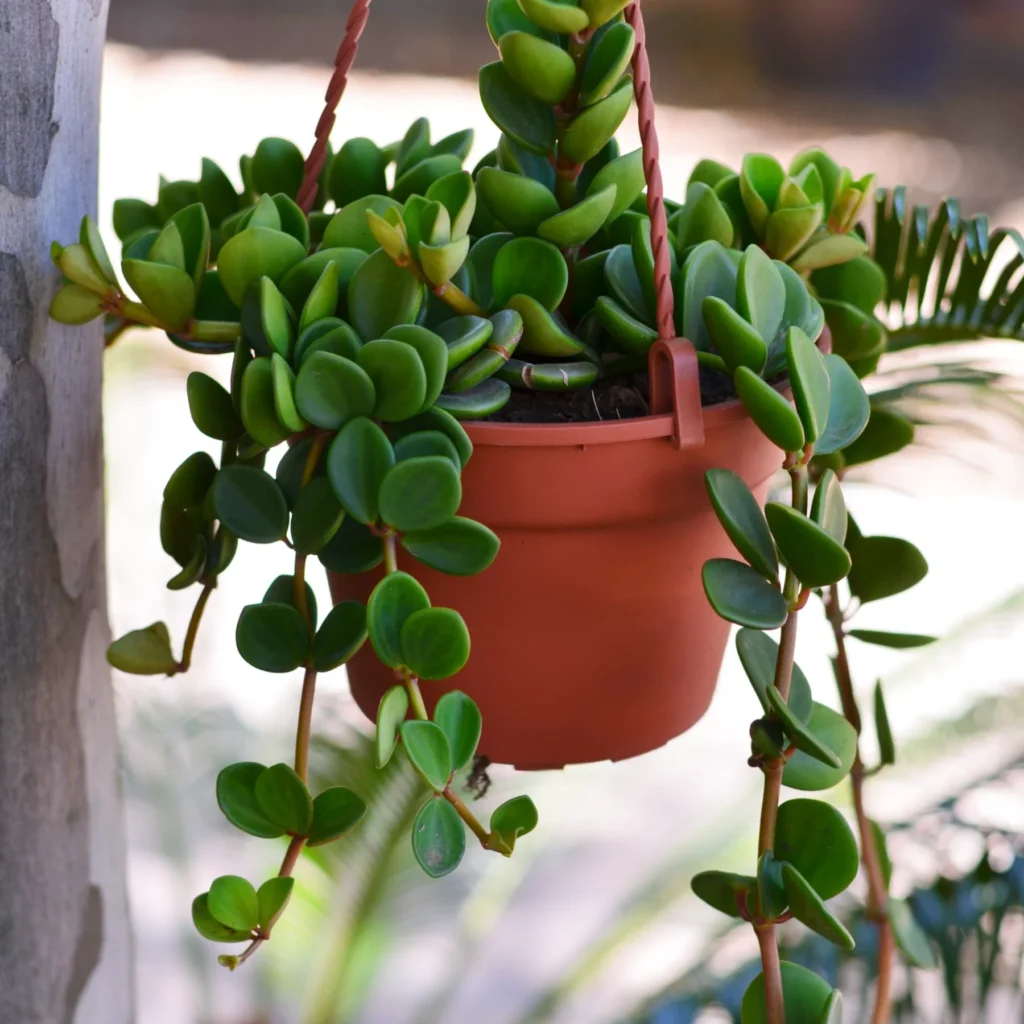
A perfect addition to any collection of Low Light Hanging Plants, Peperomia Hope features round, plump leaves growing along soft, trailing stems. This compact and slow-growing plant is incredibly low-maintenance, making it an excellent choice for busy plant owners or small indoor spaces.
Its lush, cascading foliage creates a charming and modern look in hanging baskets.
Tips for Care:
- Watering Needs: Water sparingly and allow the soil to dry out between waterings to prevent root rot.
- Light Preferences: Thrives in moderate to low indirect light, making it ideal for apartments and offices.
- Space-Saving: Its compact growth habit makes it suitable for small spaces, shelves, or hanging planters.
- Pet-Friendly: Unlike many trailing plants, Peperomia Hope is non-toxic to pets.
With its unique round leaves and easy-care nature, Peperomia Hope is a fantastic choice for anyone looking to expand their collection of Low Light Hanging Plants.
13. Lipstick Plant (Aeschynanthus radicans)
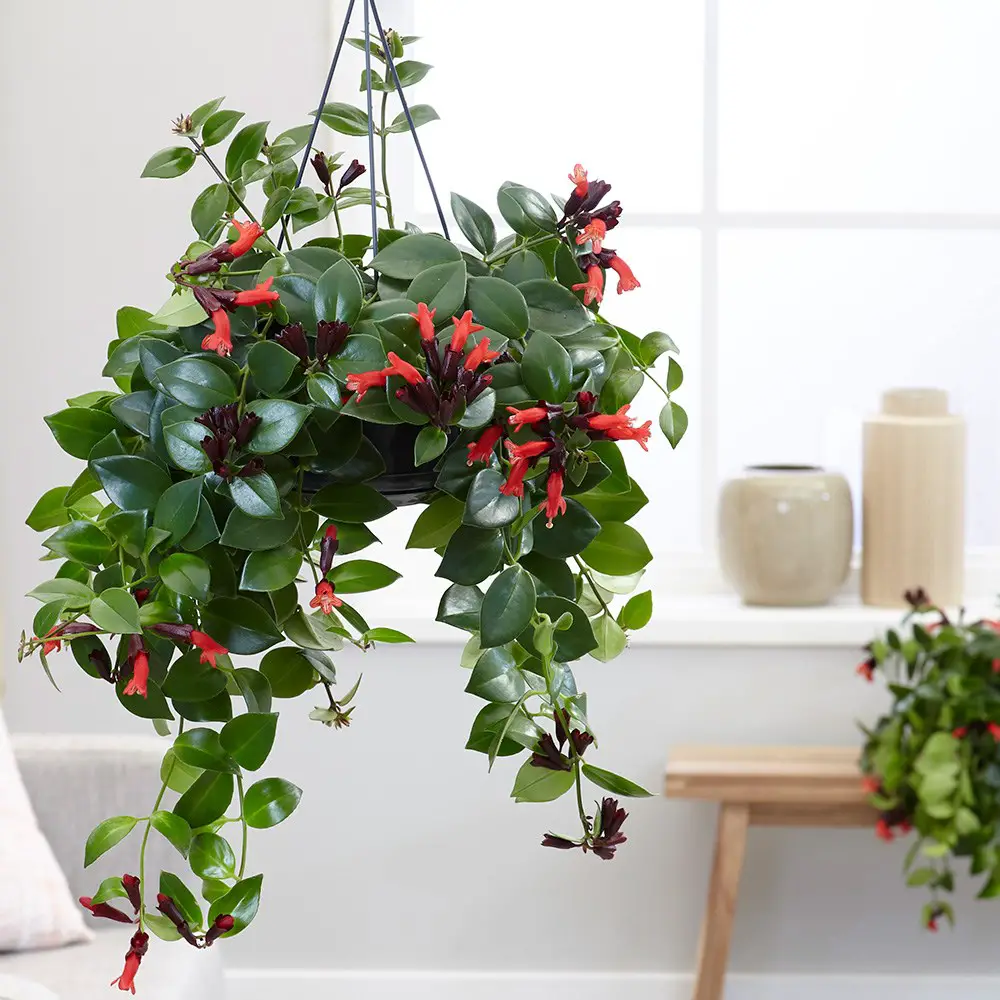
A standout among Low Light Hanging Plants, the Lipstick Plant is named for its vibrant tubular red flowers that peek out from dark green foliage, resembling tiny lipstick tubes. Its lush, trailing vines make it perfect for hanging baskets, adding both greenery and a pop of color to your indoor space.
This hardy plant thrives in low to moderate light, making it an excellent choice for dimly lit rooms.
Tips for Care:
- Watering Needs: Water regularly but ensure the soil drains well to prevent root rot.
- Encourage Full Growth: Prune periodically to promote new growth and maintain a bushy shape.
- Avoid Cold Drafts: Keep away from air conditioners, windows, or vents that may cause temperature stress.
- Flower Boost: Although it thrives in low light, providing occasional bright, indirect light can encourage more blooms.
With its cascading foliage and bold, lipstick-like blooms, the Lipstick Plant is a must-have for anyone looking to add a splash of color to their collection of Low Light Hanging Plants.
14. Chenille Plant (Acalypha hispida)
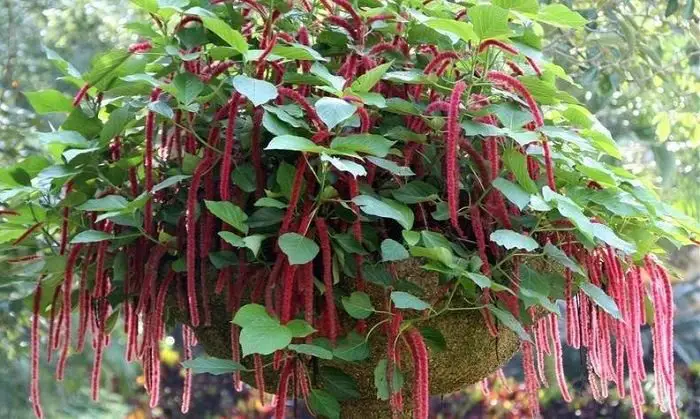
The Chenille Plant is one of the most striking Low Light Hanging Plants, known for its fuzzy, pendulous red flowers that resemble soft, trailing tassels. Its vibrant blooms and lush green foliage make it a bold, eye-catching addition to any indoor garden.
While it prefers bright, indirect light, it can adapt to lower light conditions with proper care.
Tips for Care:
- Keep Soil Moist: Maintain consistent moisture without making the soil waterlogged.
- Light Adaptability: Thrives in low to moderate light but produces more flowers with occasional bright, indirect light.
- Encourage Blooms: Remove spent flowers periodically to promote continuous blooming.
- Humidity Boost: Prefers a slightly humid environment, making it ideal for bathrooms or kitchens.
With its soft, trailing blooms and tropical charm, the Chenille Plant is a unique and beautiful choice for any collection of Low Light Hanging Plants.
Incorporating Low Light Hanging Plants into your home is a fantastic way to bring natural beauty to even the dimmest corners. Whether you prefer the cascading vines of Golden Pothos, the delicate foliage of Maidenhair Fern, or the vibrant blooms of the Lipstick Plant, there’s a perfect trailing plant for every indoor space.
These plants not only enhance your décor but also improve air quality and create a relaxing, green environment.
By choosing the right plants and providing proper care—such as well-draining soil, controlled watering, and occasional pruning—you can enjoy thriving, lush greenery without the need for bright sunlight.
From beginner-friendly options like Spider Plant to unique statement pieces like String of Pearls, these low-light-loving plants offer something for every plant enthusiast.
Embrace the beauty of Low Light Hanging Plants and transform your indoor spaces into vibrant, green retreats with minimal effort!
FAQs:
1. Can low light hanging plants survive in rooms with no windows?
Yes, some Low Light Hanging Plants like Golden Pothos, Heartleaf Philodendron, and English Ivy can tolerate very low light conditions, including rooms with no windows. However, they still need some indirect light from artificial sources like LED grow lights or ambient indoor lighting to thrive.
2. How often should I water low light hanging plants?
Watering frequency depends on the plant type, but generally, most Low Light Hanging Plants prefer their soil to dry out slightly between waterings. Succulents like String of Pearls need infrequent watering, while moisture-loving plants like Boston Fern and Maidenhair Fern require consistently damp soil. Always check the top inch of soil before watering to avoid overwatering.
3. Do low light hanging plants help purify indoor air?
Yes! Many Low Light Hanging Plants, such as Spider Plant, English Ivy, and Heartleaf Philodendron, are known for their air-purifying qualities. They can help remove toxins like formaldehyde, benzene, and carbon monoxide, improving indoor air quality while adding a fresh, natural touch to your space.

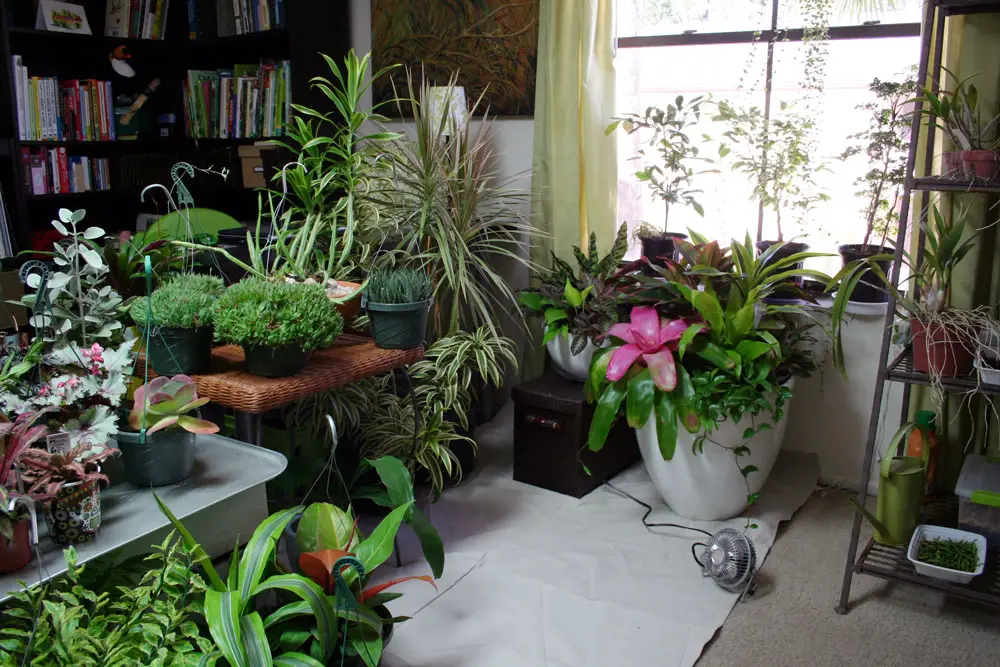
2 thoughts on “14 Low Light Hanging Plants: Drape Your Home in Green!”